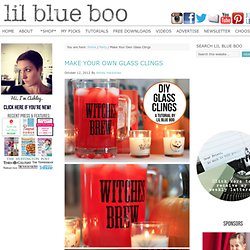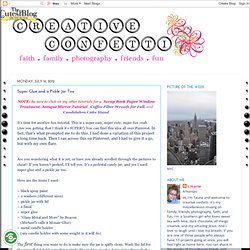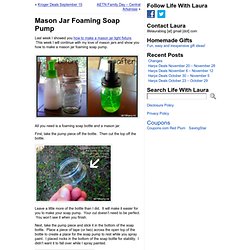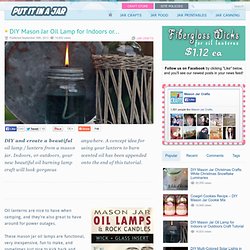

Untitled. Untitled. Untitled. Make Wine Bottle Lights — Totally Green Crafts. Want to repurpose those empty wine bottles? Make Your Own Glass Clings. This is a follow up post to the image transfers showed you how to make the other day.

I just wanted to show you another way to use them! Tape transfers are a great way to make glass clings for party decor or home decor. In this tutorial I made themed glass votive candles for Halloween and a label for a glass pitcher. My supplies were glass votives, regular packing tape, and a photocopy of Halloween clipart. Bottles Full of Light. The other day, I wrote about attempting to drill through glass and I finished up the project this weekend. I think it turned out beautifully — I love the idea of bottled light! These would be pretty by a wintery window or under an entry table. I like the way the gold paint makes the bottom of the bottles look misty and glow-y, even during the daytime. I’ve got a ton of images and DIY instructions below if you’d like to try this too. For tools and supplies, I started at my local True Value. I started with these apple juice bottles from Whole Foods. Next, I used my handy scraper tool to take off the label. Once the bottle was clean and label free, it was time to drill through the glass.
I heart Mason Jars. DIY Apothecary Jars. Bottle Reworking. Link to Bottle Labels I consider bottle slumping to be one of the really boring activities in the world, but I will share some information about it since everyone who gets anywhere near a kiln seems to be interested in it for a while.

The problem from my point of view is that unless one gets really creative, there are only a limited number of things one can do: stretch the bottle, flatten the bottle, make a spoon holder, make an ashtray. [Some people have made societal comment by arranging slumped bottle shapes in ways that suggest comment on mechanical and tired society - "Preacher and Choir", "Exhaustion", but that is more art than slumping, I think, and not me. 2002-07.] To change the form of a bottle all you need is an oven that can reach about 1400°F, which all pottery kilns and most glass annealers can do easily. For the result to survive cooling, either the kiln must lose heat especially slowly or there must be a controller that will take the temperature down slowly.
Brenda Abbott / Pinterest. We like it wild: bottle gardens. As much as we love to garden, sometimes there just aren’t enough hours in the day to do it all.

If there’s a way we can shorten our to-do list, we’ll take it. Growing herbs - Living Things. A well traveled woman. Lightbulb Bud Vase. Cool Copper Projects Warm metallic hues are easy to love but often pricey.

When you create the look... Easy Doily Bowl. Little bulb transformation to DIY a ~ _ pictures from manic children share - heap Sugar Network. Mason Blue Glass Canning Jar DIY. These jars take their name from John Landis Mason.

Mason was a young inventor who came up with the concept of a metal screw-on lid in 1858. The threaded neck on glass jars that we take for granted today was once a major innovation. Mason's developments made preserving food at home much easier and made the jars reusable. Despite the fact that Mason sold five of his glass canning jar patents in 1859, his name had staying power. Super Glue and a Pickle Jar Too. It's time for another fun tutorial.

This is a super easy, super cute, super fun craft. (Are you getting that I think it's SUPER?) Exeter 16-Jar Pendant. This is a general shipping item.

View our Shipping Information Customer Service - Shipping Information Return Policy At Pottery Barn, we take great pride in the quality and craftsmanship of our products. Attention to design, materials, safety and construction is our priority. We cannot accept returns on monogrammed, personalized, special-order items, or on items damaged through normal wear and tear. For returns of items purchased from your Pottery Barn registry, we will gladly provide a refund or exchange for the merchandise within 90 days of your event or within 90 days of purchase, whichever date is later.
You may return merchandise through the mail for a refund or replacement. Mason Jar Foaming Soap Pump. Last week I showed you how to make a mason jar light fixture.

This week I will continue with my love of mason jars and show you how to make a mason jar foaming soap pump. All you need is a foaming soap bottle and a mason jar. First, take the pump piece off the bottle. Then cut the top off the bottle. Leave a little more of the bottle than I did. Next, take the pump piece and stick it in the bottom of the soap bottle.
I used Oil Rubbed Bronze paint. While the paint was drying, I worked on the lid. Make Your Own Mason Jar Dispenser. You might have seen one or two (or three, or more) of these before…especially if you are on Pinterest!

It seems to be a VERY popular D.I.Y project! Just look at all the different canning jar dispensers I found through a quick Pinterest search! And this is only SOME of them! It’s easy to see though, how this could be so popular. Stylish Indoor or Outdoor Mason Jar Oil Lamp Lantern. DIY and create a beautiful oil lamp / lantern from a mason jar.

Indoors, or outdoors, your new beautiful oil burning lamp craft will look gorgeous anywhere. A concept idea for using your lantern to burn scented oil has been appended onto the end of this tutorial. Oil lanterns are nice to have when camping, and they’re also great to have around for power outages. Brenda Abbott / Pinterest. Olive Oil Candles - Little House on the Prairie Living. It's a good idea to be able to know how to create your own light sources in case you ever need them.
This is a simple candle that you can put together with things that you already have laying around the kitchen (besides the wick, but I'd recommend keeping that as a regular stockpiled item anyways!) There were many times when we have lost power at our house. One time in particular was in the middle of a very very cold blizzarding night. (I can't remember the exact temperature but I know it was negative something!)
The power lines must have had ice on them and just like that the house went pitch black. Convert Old Mason Jars. I buy my yeast in bulk because I make a lot of bread. It is so much cheaper than buying the tiny jars or individual packets. The yeast pictured below is a 1 pound brick and it cost $2 or $3. That is a huge savings. The only bummer about bulk yeast is how to store it easily. Well, listen up, friends, because I have the solution: Tah-dah! Just chop the top off an empty cardboard salt container, cut it to the size of a canning lid and use the canning ring to screw it in place. Then you can put the whole thing in the back of the fridge and the next time you bake, you can easily pour the yeast into your measuring spoons.
This would also be great for storing spices, baking ingredients, or powder laundry detergent bought in bulk. So the only question left is,what are you going to put in your pour-spout jar? Jars for Things. In addition to the cigar boxes, I had this idea of on-display storage for most of my Pet Shop items. With the studio housing white furniture and soft pink walls, my color-loving heart wanted my crafty supplies on display in clear vases, jars and the like, using the built-in shelves as the backdrop. Between my product packaging (shades of blue-green and goldenrod like our logo) and ready made art prints, I have plenty of color to show for. Over time, we’ve stashed “dead” candles in our cupboards, saving the ones with the prettiest jars to use later.